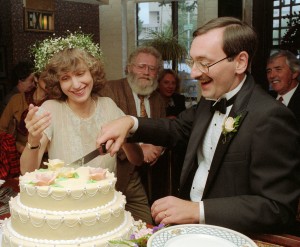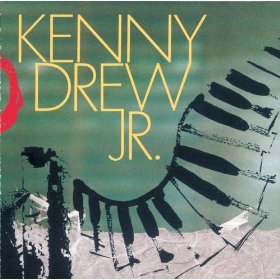Reader, I Married Her
Theme Songs Page | Previous Theme Song | Next Theme Song
Reader, I Married Her
Bebel, by Antonio Carlos Jobim, performed by Kenny Drew, Jr. (1991), “encountered” 1988
Available on Spotify | Buy it here
The pace was picking up between Mary and me now. At some point I would need to declare myself, and say some words in a church. But it was still hard to bring oneself to that point. Declaring that readiness and saying those words in a church are daunting things to do, when you are coming off a divorce, when you know your own capacity for folly and destructiveness, when you do not entirely trust yourself. The bumpy landing just getting to exclusivity I wrote about last time was never far from my mind.
Season of Transitions
And yet, it was a season of transitions, and each one helped make the others more plausible in anticipation and easier in practice.
My divorce was final in mid-1986, and with it, certain uncertainties about my commitments were resolved. At around the same point, Mary moved closer, from Charlottesville to Washington.
That summer I also left, or as the phrase went, graduated from, group therapy. It was a tearful occasion, but Group was for people who had major things to learn that they couldn’t learn elsewhere, and/or who were stuck at some critical decision necessary to their happiness, and I had learned most of what Group had to teach; nor was I stuck. It was a tearful parting, but a parting nonetheless.
And in February of 1987, I bought a house. Before doing it, I visited the place with both my kids and Mary, all together; we consciously discussed the possibility of making a nursery in the house, and indeed our plan all along was for Mary to move in in the spring.
There was an obvious direction to all this. But still we hadn’t quite reached the point of making it official, even to ourselves. And then the final clarity began.
Step-Maternal Wisdom
That summer, I was visiting my wise stepmother Etta at the family vacation cottage in the Catskills, and her advice to me was succinct: “Take your time, but not too much time.” I think she was concerned about the bad things that might happen if I kept Mary waiting too long.
And shortly afterwards, I received what a lawyer might call a solicitation for a bid. I don’t recall the exact context (some kind of joking conversation), but do I remember exactly where Mary was standing (right next to the laundry hamper in the bedroom closet, if you must know). And Mary said: “But what have you done for me lately, like marry me?”
I let the remark pass, but it was clear that the time was at hand. My serious reservations were gone. I had known her for four years. We had been exclusive for a year or more, and I had been happier than ever.
Overcoming Nerves
And yet – and yet. As with many another guy, the proposal itself somehow stuck in my throat for a while, even when I recognized that I was simply having nerves, not the kind of qualms I had experienced the first time around (also written of in these pages). But qualms are for listening to, nerves are for ignoring. So one night I summoned my courage and took Mary to dinner at the place we’d gone on the night we met (a different restaurant at this point, but in the same space), and over preliminary drinks, I tried to get out my question. I’m seldom at a loss for words, but somehow I couldn’t quite say it intelligibly, even though I knew what the answer would be. It took a couple of indirect stabs before Mary recognized my proposal for what it was. But when she did, we held hands across the table. It was done.
From that point on, things moved with a lovely directness, at least as between Mary and me. There were external problems (completing the process of moving Mary in, finding a church that would stage a nuptial for two divorced, unanulled Catholics, dealing with my mother, a category of difficulty unto itself, and of course all the logistics of planning, which ended up taking about a year), but we dealt with them as an adult couple.
Beautiful
And when we got to the moment itself, in September of 1988, the ceremony was beautiful. Most weddings are beautiful, of course – though I’ve seen one so ugly and unhappy that it could only have been, and proved to be, a prelude to divorce. But our wedding, I’m convinced, was a classic: low-key and not marred by extravagance, but still elegant and filled with happy people.  Well, something like that needed a song. But, atypically for me, there really wasn’t one to hand.
Well, something like that needed a song. But, atypically for me, there really wasn’t one to hand.
Thinking as an Artist
I reiterate a point I’ve made throughout these pieces: It has been by sheerest coincidence that I’ve come to associate most of the songs I’ve written about here with important moments in my life. I just happened to be listening to them when noteworthy things happened to happen. Very little artistry, indeed, very little volition has been involved. But at this paramount moment, I aspired to something more precisely right. By now I was thinking as an artist, specifically as a film director (even though that is not a medium in which I’ve ever tried to work in real life). I was dreaming of a movie about my recent life in which my remarriage would be the happy conclusion.[1]
I needed a song for the end credits. I did not see the wedding itself as the last shot; rather, it would be an image of fictionalized versions of Mary and me, shot from behind, walking away holding hands along a springtime street in the twilight, as the camera pedestaled up until finally all you saw, before the credits rolled, would be the blossoms in the trees. A very specific image, in other words, conventionally shot to tell the viewer firmly: happy ending.
I knew intellectually, of course, that life never gives us totally happy endings. Even the best marriages have their rough patches, and I was sophisticated enough now to expect that. But the hell with what I knew; this was about what I felt. And even before we married, what I felt was how incredibly lucky and happy I was to have Mary. There’s a sentence in George Gissing’s novel Sleeping Fires which summed up my feelings about her: “It was the woman whom a man in his maturity desires unashamed.”[2] And there I was, unashamed after a long process.
To capture all that, the song would have be something that began in a long and hesitant fashion, but then moved from diffidence to confidence, lyricism, and joy.
Reader, I Found It
I finally found that song in a music store a few years later while taking a needed extended lunch break from my job being a square peg at an outfit I’ll call the Round Hole Law Firm. There aren’t so many music stores now, but this one still (as of 2014) exists, albeit in a different location, catering now as then to a mainly African American clientele. And where better to stay on top of jazz? Periodically at that point I’d wander in and ask for something new and exciting. On this occasion, I was handed a self-titled cassette album: Kenny Drew, Jr. Drew played a very dominant piano in front of a trio for much of the album. I’d never heard of Kenny Drew, Sr. or Jr., so the name meant nothing to me.
When I played it, I liked a lot of it and didn’t like a lot of it. (Some of the boppier numbers struck me as nearly cacophonous.) But there were a couple of lovely things in there, one of which was Bebel. I didn’t know then what the name portended; for some reason I even failed to note that the song was written by Jobim, the king of the bossa nova.[3] I just knew the song was one of the coolest things I’d ever heard. It opens with a full minute of the piano hesitantly picking a melody, two notes at a time, staggering uncertainly up and down the octaves, as if it is trying to make up its mind about a key and a register and a melody, but then there comes a moment when the melody finally commits. Then it starts to flow, smoothly, inventively and elegantly, for another five minutes, in a style reminiscent of Brubeck or Luiz Eça, each of whom I’ve written about in these pages.
The song was perfect, actually far more perfect than Jobim’s original, which lacks much of Drew’s hesitancy or dramatic contrast – another way of saying Drew adds these things. (And Jobim’s voice can’t handle the vocal range Jobim the composer writes for Jobim the singer.)
So this was the Bebel to start with. And it captures, as no other song I encountered at that time, the wonder of that moment, when the most important part of my life came definitively together, when, having cleared aside every impediment, especially those within myself, I was able to ask for what I needed, and to say “I do” when I was given the chance to commit to it.
Reader, I married her.
And Bebel was the song.
________________
[1] I was writing a novel at the time, or trying to, about how things fell apart, and how they came together again, on the model of C.D.B. Bryan’s quite autobiographical novel Beautiful Women, Ugly Scenes, which I still think is the best divorce-and-remarriage novel I ever read. According to a blog post by Bryan’s son, despite the fact that Bryan wrote screenplays himself and had some connections in the movie-making world, no movie-maker ever came calling to film that book. (Bryan died in 2009, so it seems as if the moment for that has passed.) But I think it would have worked outstandingly as a movie.
[2] 1895, 1983 reissue by University of Nebraska Press, at page 15.
[3] The song is not well-known in the U.S., I suspect because the original recording is late-period Jobim, recorded after the bossa nova craze had ended. If you read the lyrics, it seems to be a song about a somewhat generic young woman (Jobim wrote a few, as we know), perhaps crying because she is eager for love. I now strongly suspect the song was written for Bebel Gilberto (Bebel being in this case a nickname for Isabel), daughter of Joao Gilberto, today a performer in her own right, who debuted at age seven in an album with her mother Miucha and Jobim, but who was in her late teens when, in 1987, Jobim came out with the album Passarim from which this song is taken. If the song really was personal from Jobim to Bebel Gilberto, it seems a little creepy, being that he would have been about sixty at the time, and it predicts that when he kisses her on the mouth, it will make her dream about her future of falling in love. And actually, there is a touch of ephebophilia about The Girl from Ipanema, too, given that the subject is the sighing of older men, too old for the young woman passing through their midst, at the sight of her. (To be fair, the lyrics to that song were by Vinicius de Moraes, not Jobim.) For what it’s worth, Bebel has recorded The Girl from Ipanema with Kenny G. If Jobim ever creeped her out, that reaction is not much publicized.
Copyright (c) Jack L. B. Gohn, except for album artwork
